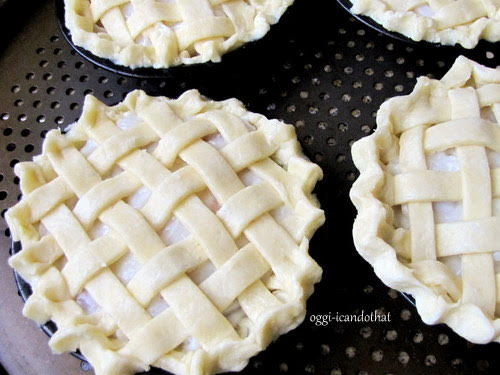creamy buco strips and ube jam in buttery flaky crust
The meat of one of the fresh buco I bought for buco pie is light purple in color and its water is brownish light purple. Isn't it weird? Taking a cue from this unusual buco coloring I added a thin layer of ube (purple yam) jam in between creamy buco filling. The combination is oh so delicious. Mmmm.

light purple buco meat
The past week, I have been busy honing my skills in making lattice-top pie. I have never made one before because I always thought I'd make a mess of it. And I did with the first pie I practiced on, Cherry Pie. I cut the strips too thin and spaced them unevenly and they are sort of crooked which is okay I guess for a first try and I don't mind how it looks because the pie is deliciously sweet and tart.
The first of the small buco pies was easier to handle. I was able to make the remaining top crusts more uniform and acceptable in appearance and I finished each one much quicker too.
The recipe for Buco Pie is here; you might have to reduce the amount of cornstarch because a reader who has made this pie said the filling was gummy. Check and eyeball the consistency while cooking and add cornstarch mixture as needed.

they look much better after 2 tries

4-inch buco pies


light purple buco meat
The past week, I have been busy honing my skills in making lattice-top pie. I have never made one before because I always thought I'd make a mess of it. And I did with the first pie I practiced on, Cherry Pie. I cut the strips too thin and spaced them unevenly and they are sort of crooked which is okay I guess for a first try and I don't mind how it looks because the pie is deliciously sweet and tart.
The first of the small buco pies was easier to handle. I was able to make the remaining top crusts more uniform and acceptable in appearance and I finished each one much quicker too.
The recipe for Buco Pie is here; you might have to reduce the amount of cornstarch because a reader who has made this pie said the filling was gummy. Check and eyeball the consistency while cooking and add cornstarch mixture as needed.
they look much better after 2 tries
4-inch buco pies
This is my entry to this week's Lasang Pinoy, Sundays: Crusty
Lasang Pinoy Sundays is a weekly food photography meme, Pinoy style, hosted by SpiCes.
Lasang Pinoy Sundays is a weekly food photography meme, Pinoy style, hosted by SpiCes.

